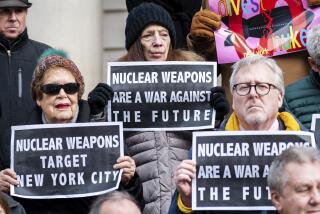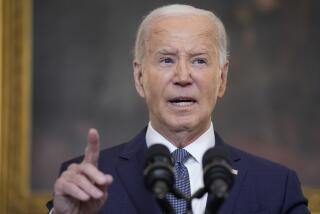Soviets Offer New Space Arms Treaty; U.S. Decries Move to ‘Hobble’ SDI Program
- Share via
GENEVA — The Soviet Union offered a new draft treaty proposal on limiting weapons systems in outer space at the nuclear arms talks here Wednesday, but the U.S. delegation immediately dismissed it as containing “little that is new” and an effort to “hobble” America’s space-based missile program.
For their part, Soviet negotiators said they had not found anything new in the American concessions that were offered here Tuesday on intermediate-range nuclear weapons. At a news conference to announce the space weapons proposal, Alexei A. Obukhov, deputy head of the Soviet delegation at the arms talk, declared, “I read about new American proposals, but what we heard yesterday cannot be described this way.”
Pact ‘Close at Hand’
Despite this negative tone, Obukhov did say that elimination of intermediate-range nuclear missiles worldwide, both those with a range of 600 to 3,000 miles and those with a shorter range of 300 to 600 miles, was “close at hand.”
“There is a lot of work but it can be completed and then the basis of negotiations in other areas may be good,” he said.
Obukhov said that the draft treaty that his delegation presented Wednesday proposes to commit both sides to continuing the Anti-Ballistic Missile (ABM) Treaty of 1972 for another 10 years.
The Soviets maintain the treaty bars such programs as President Reagan’s Strategic Defense Initiative, the space-based missile defense system now being researched by the United States. The Reagan Administration has argued that the treaty would permit testing of SDI, or “Star Wars” as the program is commonly known.
The new Soviet proposal would restrict research on space-based defense systems to “laboratories on Earth, at institutes, at ABM test ranges and at plants, both indoors and outdoors.” It also offers a list of devices “which may not be put into outer space or be stationed there”--a list that Obukhov later said includes “missiles, electro-dynamic or other accelerators and lasers.”
Such a ban would cripple the SDI program as currently envisioned.
The Soviet negotiator firmly tied the question of any future reduction in strategic nuclear missiles to agreement on “strengthening of the ABM treaty regime and prevention of an arms race in outer space.”
Seeking to maintain the propaganda initiative in the arms control arena, the Soviet delegation had asked Tuesday for a special plenary meeting Wednesday of the negotiating teams from both sides to present the draft treaty, which they titled, “Agreement on certain measures to strengthen the regime of the treaty on limitations of anti-ballistic missile systems and to prevent an arms race in outer space.”
They then scheduled a news conference with Obukhov at the Soviet mission at 3 p.m.
After the Americans received the new Soviet proposal at the morning plenary session, they announced that they would hold a news conference at 4:30 p.m. It was the first time since these arms talks had their origins in the negotiations on the first Strategic Arms Limitation Treaty (SALT I) in Helsinki and Vienna in the 1960s that there has ever been such a tit-for-tat exchange of press conferences.
With the old rules of confidentiality that used to surround the arms talks almost totally abandoned, negotiations are increasingly being conducted by public statements from the Kremlin and the White House, by press conferences, television interviews, leaks, background briefings and opinion page articles signed by the leading negotiators on each side.
The swift and public U.S. response to Obukhov and the Soviet proposal was given by Ambassador Henry F. Cooper, the negotiator who heads the U.S. team dealing with the defense and outer-space portion of these three-part negotiations under the overall leadership of Ambassador Max M. Kampelman. The other two negotiating groups deal with strategic or offensive nuclear weapons and the intermediate-range nuclear weapons.
Replying to the Soviet proposal, Cooper said:
“On balance our reading has so far revealed little that is new beyond certain matters of details. We are disappointed that the Soviet Union continues to hold a 50% reduction in strategic offensive arms hostage to stopping the U.S. Strategic Defense Initiative program.
U.S. Reply
“The Soviets argue that we need to ‘strengthen’ the ABM Treaty in order for deep reductions in strategic weapons to take place,” Cooper continued. “Actually, they are trying to amend the ABM Treaty to hobble our SDI program.
Arguing that the terms of the old ABM treaty already should lead to reductions in strategic weapons, Cooper said, “The ABM treaty does not need strengthening--its promises need fulfilling. We should achieve a treaty on 50% reductions in strategic weapons--that is the next step.”
More to Read
Sign up for Essential California
The most important California stories and recommendations in your inbox every morning.
You may occasionally receive promotional content from the Los Angeles Times.










